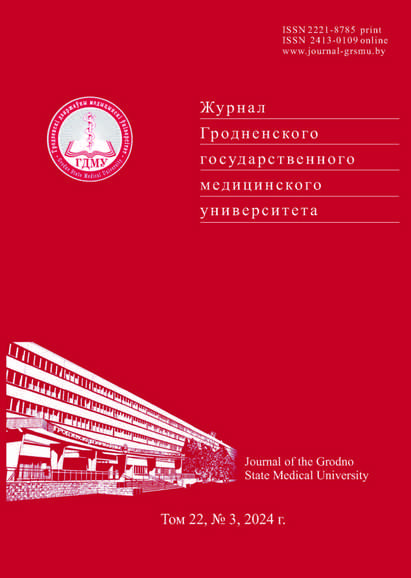ПРОГНОЗНАЯ ОЦЕНКА КОЛЛАПСА СУСТАВНОЙ ПОВЕРХНОСТИ ПРИ СУБХОНДРАЛЬНОМ ПЕРЕЛОМЕ НЕДОСТАТОЧНОСТИ КОСТНОЙ ТКАНИ КОЛЕННОГО СУСТАВА (SIFK)

Аннотация
Введение. Субхондральный перелом недостаточности костной ткани коленного сустава (subchondral insufficiency fracture of the knee, SIFK) – частая причина боли в коленном суставе у пациентов старше 50 лет. Диагностика данной патологии на ранней стадии имеет определенные сложности, поскольку требует выполнения магнитно-резонансной томографии (МРТ). Цель исследования. Определить взаимосвязь между размером очага субхондрального перелома недостаточности коленного сустава, индекса массы тела пациента и риском возникновения коллапса суставной поверхности. Материал и методы. У 35 пациенток с субхондральным переломом недостаточности определялся размер поражения во фронтальной и сагиттальной плоскостях, а также его объем (по данным МРТ). Полученные результаты позволили оценить риск коллапса суставной поверхности. Результаты. По результатам исследования выявлена взаимосвязь между размером очага поражения и риском коллапса суставной поверхности при субхондральном переломе недостаточности коленного сустава. Переднезадний размер очага более 14,1 мм, поперечный – более 10,2 мм и краниокаудальный размер более 1,22 мм – фактор риска последующего коллапса суставной поверхности и прогрессии остеоартрита коленного сустава. При проведении анализа зависимости индекса массы тела (ИМТ) и развития коллапса суставной поверхности не выявлено определенного значения ИМТ, при котором происходила бы импрессия суставной поверхности. Выводы. Определен фактор риска коллапса суставной поверхности у пациентов с субхондральным переломом недостаточности костной ткани коленного сустава позволяющий прогнозировать исходы лечения заболевания. Показатель индекса массы тела и развитие коллапса суставной поверхности не коррелируют между собой.
Литература
Ahlbäck S, Bauer GC, Bohne WH. Spontaneous osteonecrosis of the knee. Arthritis Rheum. 1968;(11):705-733. https://doi.org/10.1002/art.1780110602.
Yamamoto T, Bullough PG. Spontaneous osteonecrosis of the knee: the result of subchondral insufficiency fracture. J Bone Joint Surg Am. 2000;(82):858-866. https://doi.org/10.2106/00004623-200006000-00013.
Hatanaka H, Yamamoto T, Motomura G, Sonoda K, Iwamoto Y. Histopathologic findings of spontaneous osteonecrosis of the knee at an early stage: a case report. Skeletal Radiol. 2016;45:713-716. https://doi.org/10.1007/s00256-016-2328-4.
Tanaka Y, Mima H, Yonetani Y, Shiozaki Y, Nakamura N, Horibe S. Histological evaluation of spontaneous osteonecrosis of the medial femoral condyle and short-term clinical results of osteochondral autografting: A case series. Knee. 2009;16:130-135. https://doi.org/10.1016/j.knee.2008.10.013.
Takeda M, Higuchi H, Kimura M, Kobayashi Y, Terauchi M, Takagishi K. Spontaneous osteonecrosis of the knee: histopathological differences between early and progressive cases. J Bone Joint Surg Br. 2008;90:324-329. https://doi.org/10.1302/0301-620X.90B3.18629.
MacDessi SJ, Brophy RH, Bullough PG, Windsor RE, Sculco TP. Subchondral fracture following arthroscopic knee surgery. A series of eight cases. J Bone Joint Surg Am. 2008;90:1007-1012. https://doi.org/10.2106/JBJS.G.00445.
Hussain ZB, Chahla J, Mandelbaum BR, Gomoll AH, LaPrade RF. The role of meniscal tears in spontaneous osteonecrosis of the knee: A systematic review of suspected etiology and a call to revisit nomenclature. Am J Sports Med. 2019;47:501-507. https://doi.org/10.1177/0363546517743734.
Jose J, Pasquotti G, Smith MK, Gupta A, Lesniak BP, Kaplan LD. Subchondral insufficiency fractures of the knee: review of imaging findings. Acta Radiol. 2015;56(6):714-719. https://doi.org/10.1177/0284185114535132.
Barras LA, Pareek A, Parkes CW, Song BM, Camp CL, Saris DBF, Stuart MJ, Krych AJ. Post-arthroscopic subchondral insufficiency fractures of the knee yield high rate of conversion to arthroplasty. Arthroscopy. 2021;37(8):2545-53. https://doi.org/10.1016/j.arthro.2021.03.029.
Husain R, Nesbitt J, Tank D, Verastegui MO, Gould ES, Huang M. Spontaneous osteonecrosis of the knee (SONK): the role of MR imaging in predicting clinical outcome. J Orthop. 2020;22:606-611. https://doi.org/10.1016/j.jor.2020.11.014.
Pape D, Seil R, Fritsch E, Rupp S, Kohn D. Prevalence of spontaneous osteonecrosis of the medial femoral condyle in elderly patients. Knee Surg Sports Traumatol. Arthrosc. 2002;10:233-240. https://doi.org/10.1007/s00167-002-0285-z.
Plett SK, Hackney LA, Heilmeier U, Nardo L, Yu A, Zhang CA, Link TM. Femoral condyle insufficiency fractures: associated clinical and morphological findings and impact on outcome. Skeletal Radiol. 2015;44:1785-1794. https://doi.org/10.1007/s00256-015-2234-1.
Lansdown DA, Shaw J, Allen CR, Ma CB. Osteonecrosis of the knee after anterior cruciate ligament reconstruction: a report of 5 cases. Orthop J Sports Med. 2015;3(3):2325967115576120. https://doi.org/10.1177/2325967115576120.
Pareek A, Parkes CW, Bernard C, Camp CL, Saris DBF, Stuart MJ, Krych AJ. Spontaneous Osteonecrosis/Subchondral Insufficiency Fractures of the Knee: High Rates of Conversion to Surgical Treatment and Arthroplasty. J Bone Joint Surg Am. 2020;102:821-829. https://doi.org/10.2106/JBJS.19.00381.
Ochi J, Nozaki T, Nimura A, Yamaguchi T, Kitamura N. Subchondral insufficiency fracture of the knee: Review of current concepts and radiological differential diagnoses. Jpn. J. Radiol. 2022;40:443-457. https://doi.org/10.1007/s11604-021-01224-3.
Allam E, Boychev G, Aiyedipe S, Morrison W, Roedl JB, Singer AD, Gonzalez FM. Subchondral insufficiency fracture of the knee: unicompartmental correlation to meniscal pathology and degree of chondrosis by MRI. Skeletal Radiol. 2021;50:2185-94. https://doi.org/10.1007/s00256-021-03777-w.
Aglietti P, Insall JN, Buzzi R, Deschamps G. Idiopathic osteonecrosis of the knee. Aetiology, prognosis and treatment. J Bone Joint Surg Br. 1983;65:588-97. https://doi.org/10.1302/0301-620X.65B5.6643563.
Lotke PA, Abend JA, Ecker ML. The treatment of osteonecrosis of the medial femoral condyle. Clin Orthop Relat Res. 1982;171:109-16.






























